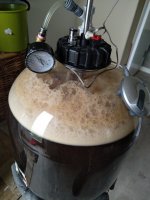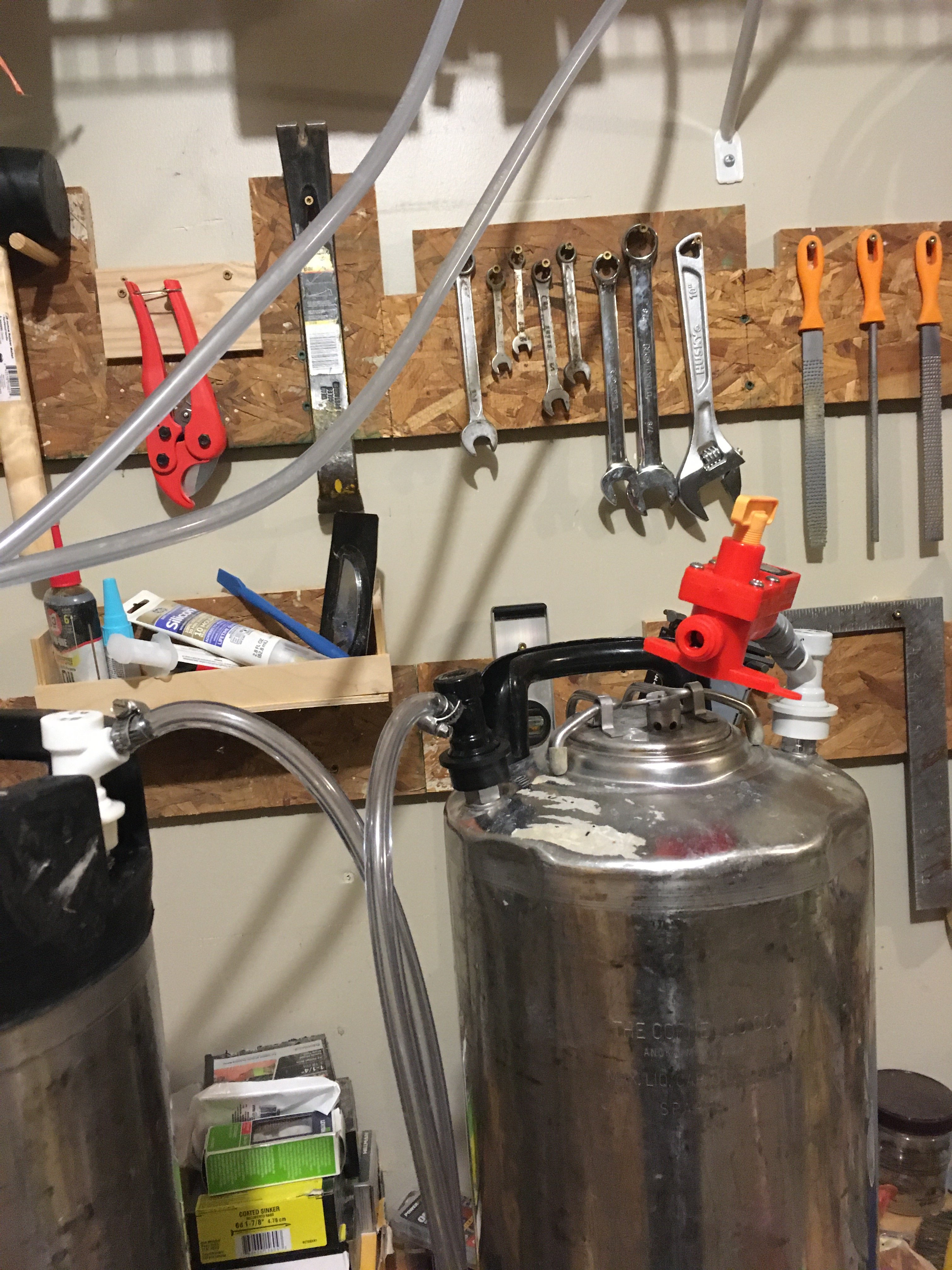Cheesy_Goodness
Well-Known Member
Sorry if this has been posted before, I did some research on this but wasn’t able to find anything with this exact set up.
I’ve been out of the fermentation game for quite some time now, hoping to get back in to it this summer. I got to thinking about pressure fermentation and how I could make it work with my setup but I’m not entirely sure this hypothetical process will work. Poke all the holes you can.
I’ve got a fermentation fridge that just barely can hold two corny kegs. Keg 1 and Keg 2 would both be there.
Keg 1 is my fermentation vessel with a floating dip tube; Keg 2 is serving vessel. Both have been sanitized beforehand.
Keg 1 ferments under pressure with a spunding valve attached at, let’s say 10 PSI. The output of the spunding valve goes to the input of Keg 2. Keg 2 has another spunding valve on it’s output.
My wort and yeast go in to Keg 1. I'll lightly pressurize it just to get it to seal and the beer ferments. My understanding is that since it’s under pressure I shouldn’t have to worry too much about blow off and can get pretty close to 5 full gallons in the keg. The excess pressure from Keg 1’s spunding valve goes in to Keg 2 and ultimately flushes it of all oxygen. I’ve seen posts around the internet that say fermentation produces enough Co2 to push starsan out of a keg so I’m assuming it’ll work the same without any liquid to push out. The spunding valve on the output of Keg 2 set to slightly less PSI than Keg 1, let’s say around 8-9 PSI.
When fermentation is complete I can do a closed transfer to the serving vessel by removing both spunding valves, and attaching a length of tubing on the output of Keg 1, and the other end to the output (filling from the bottom with a normal dip tube) of Keg 2. If the pressure in Keg 2 is less than Keg 1 my thought is it’ll slowly siphon the already carbonated beer into Keg 2. This will probably need dialed in a bit and may require hooking up my Co2 tank to Keg 1 to give it a boost, or tugging on Keg 2’s PRV every now and again.
If all goes according to plan, at the end of fermentation I’ll have:
That’s about it. Like I mentioned I saw several variants on this plan but nothing exactly like this so I wanted to run it by you fine folks before I get the equipment this requires.
Thoughts?
I’ve been out of the fermentation game for quite some time now, hoping to get back in to it this summer. I got to thinking about pressure fermentation and how I could make it work with my setup but I’m not entirely sure this hypothetical process will work. Poke all the holes you can.
I’ve got a fermentation fridge that just barely can hold two corny kegs. Keg 1 and Keg 2 would both be there.
Keg 1 is my fermentation vessel with a floating dip tube; Keg 2 is serving vessel. Both have been sanitized beforehand.
Keg 1 ferments under pressure with a spunding valve attached at, let’s say 10 PSI. The output of the spunding valve goes to the input of Keg 2. Keg 2 has another spunding valve on it’s output.
My wort and yeast go in to Keg 1. I'll lightly pressurize it just to get it to seal and the beer ferments. My understanding is that since it’s under pressure I shouldn’t have to worry too much about blow off and can get pretty close to 5 full gallons in the keg. The excess pressure from Keg 1’s spunding valve goes in to Keg 2 and ultimately flushes it of all oxygen. I’ve seen posts around the internet that say fermentation produces enough Co2 to push starsan out of a keg so I’m assuming it’ll work the same without any liquid to push out. The spunding valve on the output of Keg 2 set to slightly less PSI than Keg 1, let’s say around 8-9 PSI.
When fermentation is complete I can do a closed transfer to the serving vessel by removing both spunding valves, and attaching a length of tubing on the output of Keg 1, and the other end to the output (filling from the bottom with a normal dip tube) of Keg 2. If the pressure in Keg 2 is less than Keg 1 my thought is it’ll slowly siphon the already carbonated beer into Keg 2. This will probably need dialed in a bit and may require hooking up my Co2 tank to Keg 1 to give it a boost, or tugging on Keg 2’s PRV every now and again.
If all goes according to plan, at the end of fermentation I’ll have:
- Carbonated beer (spunding valve)
- Clear beer, at least in theory (floating dip tube)
- Close to nothing spent on Co2
- Very little time spent on cleaning/racking (at least on the back end)
That’s about it. Like I mentioned I saw several variants on this plan but nothing exactly like this so I wanted to run it by you fine folks before I get the equipment this requires.
Thoughts?










